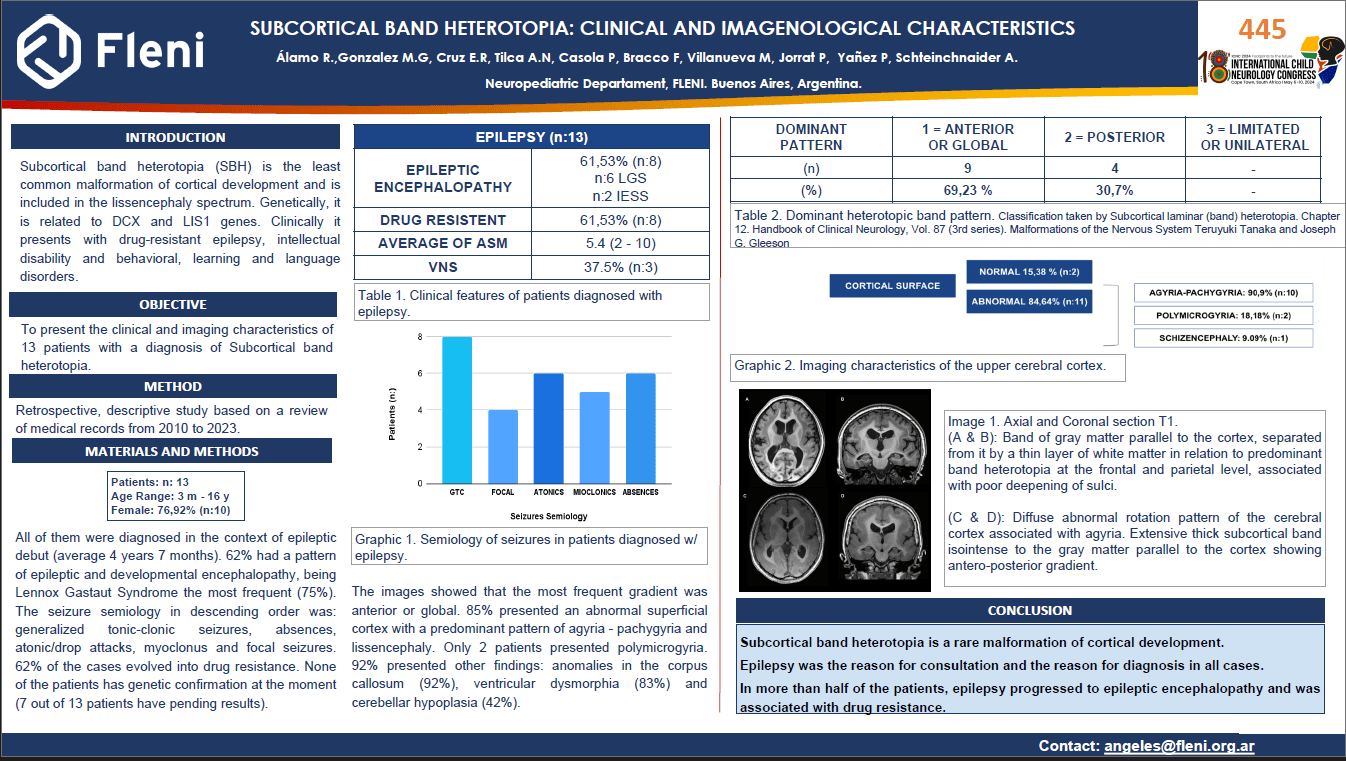SUBCORTICAL BAND HETEROTOPIA: CLINICAL AND IMAGENOLOGICAL CHARACTERISTICS.
INTRODUCTION: Subcortical band heterotopia (SBH) is the least common malformation of cortical development and is included in the lissencephaly spectrum. Genetically, it is related to DCX and LIS1 genes. Clinically it presents with drug-resistant epilepsy, intellectual disability and behavioral, learning and language disorders.
OBJECTIVES: Present the clinical and imaging characteristics of 13 patients with a diagnosis of Subcortical band heterotopia. Retrospective, descriptive study based on a review of medical records from 2010 to 2023.
MATERIALS AND METHODS: Thirteen patients are presented, 10 female. All of them were diagnosed in the context of epileptic debut (average 4 years 7 months). 62% had a pattern of epileptic and developmental encephalopathy, being Lennox Gastaut Syndrome the most frequent (75%). The seizure semiology in descending order was: generalized tonic-clonic seizures, absences, atonic/drop attacks, myoclonus and focal seizures. 62% of the cases evolved into drug resistance. None of the patients has genetic confirmation at the moment (7 out of 13 patients have pending results). The images showed that the most frequent gradient was anterior or global. 85% presented an abnormal superficial cortex with a predominant pattern of agyria - pachygyria and lissencephaly. Only 2 patients presented polymicrogyria. 92% presented other findings: anomalies in the corpus callosum (92%), ventricular dysmorphia (83%) and cerebellar hypoplasia (42%).
CONCLUSION: SBH is a rare malformation of cortical development. All the patients presented with epilepsy and intellectual disability was a constant feature. Due to the complexity of these patients, treatment and follow - up represent a challenge.
Maria Gala Gonzalez
Rául Carrea Institute for Neurological Research- FLENI-
Argentina
Eliana Romina Elisa Cruz
Rául Carrea Institute for Neurological Research- FLENI-
Argentina
Natali Tilca Gerez
Rául Carrea Institute for Neurological Research- FLENI-
Argentina
Maria Florencia Bracco
Rául Carrea Institute for Neurological Research- FLENI-
Argentina
Pablo Jorrat
Rául Carrea Institute for Neurological Research- FLENI-
Argentina
Mercedes Villanueva
Rául Carrea Institute for Neurological Research- FLENI-
Argentina
Paulina Yañez
Rául Carrea Institute for Neurological Research- FLENI-
Argentina
Rocio Elizabeht Alamo
Rául Carrea Institute for Neurological Research- FLENI-
Argentina
Angeles Schteinschnaider
Rául Carrea Institute for Neurological Research- FLENI-
Argentina

Rocio Alamo
Raúl Carrea Institute for Neurological Research-FLENI
Argentina